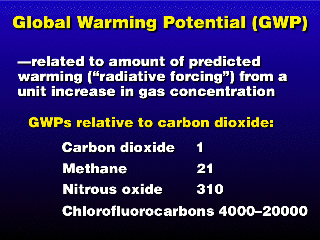 The Global Warming Potential (GWP) (also sometimes called the Greenhouse Warming Potential)
is used to rank the relative effectiveness of a gas at producing a greenhouse
effect. Generally, the higher the GWP, the greater the amount of infrared radiation that a molecule
of the gas absorbs, and thus the greater the contribution to a greenhouse warming
effect from that particular gas molecule.
The Global Warming Potential (GWP) (also sometimes called the Greenhouse Warming Potential)
is used to rank the relative effectiveness of a gas at producing a greenhouse
effect. Generally, the higher the GWP, the greater the amount of infrared radiation that a molecule
of the gas absorbs, and thus the greater the contribution to a greenhouse warming
effect from that particular gas molecule.
A major implication of the much-higher
GWPs for methane (CH4), nitrous oxide (N2O), and CFCs is that it takes less
of these gases to produce a greenhouse warming effect than CO2. So, while the
concentrations of the minor greenhouse gases are very small relative to CO2,
they could be important later on since their concentrations are beginning to
increase at rates similar to CO2.
The amount of the overall warming
of the atmosphere from each individual greenhouse gas must be indexed to the
amount of each gas in the atmosphere. Notice that a) amount of the minor
greenhouse gases are on the order of 1 part per million or so (1 ppmv = 1/1,000,000
by volume; a percent would be 1/100); and b) the concentrations have
begun to increase at a much accelerated rate in the last century. Compare these
concentrations to that of CO2 (at about 360 ppmv). While the concentrations
are low now, allowing their concentrations to increase at their current accelerating
rates and coupling that with the higher GWPs may result in a substantial portion
of the future greenhouse effect being produced by these gases instead of CO2/H2O.



 The Global Warming Potential (GWP) (also sometimes called the Greenhouse Warming Potential)
is used to rank the relative effectiveness of a gas at producing a greenhouse
effect. Generally, the higher the GWP, the greater the amount of infrared radiation that a molecule
of the gas absorbs, and thus the greater the contribution to a greenhouse warming
effect from that particular gas molecule.
The Global Warming Potential (GWP) (also sometimes called the Greenhouse Warming Potential)
is used to rank the relative effectiveness of a gas at producing a greenhouse
effect. Generally, the higher the GWP, the greater the amount of infrared radiation that a molecule
of the gas absorbs, and thus the greater the contribution to a greenhouse warming
effect from that particular gas molecule.